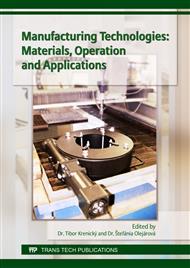[1]
J. Jurko, M. Džupon, A. Panda, J. Zajac, Study influence of plastic deformation a new extra low carbon stainless steels XCr17Ni7MoTiN under the surface finish when drilling, Advanced Materials Research 541 (2012) 1312-1315.
DOI: 10.4028/www.scientific.net/amr.538-541.1312
Google Scholar
[2]
T. Krenický, Implementation of Virtual Instrumentation for Machinery Monitoring, in: Scientific Papers: Operation and Diagnostics of Machines and Production Systems Operational States: Vol. 4, RAM-Verlag, Lüdenscheid, 2011, pp.5-8.
Google Scholar
[3]
T. Krenický, P. Jacko, Real-time monitoring of technical systems operation (Real-time monitoring prevádzky technických systémov), Strojárstvo Extra 5 (2011) 32/1-32/2. (in Slovak).
Google Scholar
[4]
J. Svetlík, P. Demeč, Principles of modular architecture in the manufacturing technology, Applied Mechanics and Materials 309 (2013) 105-112.
DOI: 10.4028/www.scientific.net/amm.309.105
Google Scholar
[5]
L. Straka, M. Rimar, I. Corny, J. Mihalcova, Increasing of operational reliability of technical system, in: Annals of DAAAM and Proceedings of the International DAAAM Symposium, 2011, 1089-1090.
DOI: 10.2507/22nd.daaam.proceedings.531
Google Scholar
[6]
J. Mascenik, S. Pavlenko, L. Bicejova, Component selected parametres geometrical tolerance value experimental specification, Applied Mechanics and Materials 389 (2013) 1096-1099.
DOI: 10.4028/www.scientific.net/amm.389.1096
Google Scholar
[7]
A. Šmeringaiová, J. Valíček, S. Hloch, J. Goban, Three views on kinematic analysis of crank mechanism in educational process, in: Proc. of Int. Sci. Geoconference and EXPO, 3, 2011, 1309-1314.
DOI: 10.5593/sgem2011/s23.114
Google Scholar
[8]
J. Novak-Marcincin, V. Fecova, L. Novakova-Marcincinova, M. Janak, J. Barna, M. Kocisko, Virtools and its application in MOCAP and creation of the scripts for animations of models, Engineering Review 32 (2012) 96-102.
DOI: 10.1063/1.4707641
Google Scholar
[9]
I. Góts, J. Zajac, I. Vojtko, Vorrichtung zum Messen des Abnutzungsgrades von Schneidwerkzeugen, Technisches Messen 62 (1995) 8-11.
DOI: 10.1524/teme.1995.62.jg.8
Google Scholar
[10]
Š. Gašpár, J. Maščenik, J. Paško, The effect of degassing pressure casting molds on the quality of pressure casting, Advanced Materials Research 428 (2012) 43-46.
DOI: 10.4028/www.scientific.net/amr.428.43
Google Scholar
[11]
Š. Gašpár, J. Paško, Influence of technological factors of die casting on mechanical properties of castings from silumin, Lecture Notes in Electrical Engineering 240 (2013) 713-722.
DOI: 10.1007/978-94-007-6738-6_88
Google Scholar
[12]
L. Straka, Operational reliability of mechatronic equipment based on pneumatic artificial muscle, Applied Mechanics and Materials 460 (2014) 41-48.
DOI: 10.4028/www.scientific.net/amm.460.41
Google Scholar
[13]
K. Monkova, P. Monka, Vibrodiagnostics and its application in manufacturing practicem, Applied Mechanics and Materials 390 (2013) 220-224.
DOI: 10.4028/www.scientific.net/amm.390.220
Google Scholar
[14]
I. Orlovský, M. Hatala, J. Duplák, Balance equation - an essential element of the definition of the drying process, Advanced Materials Research 849 (2013) 310-315.
DOI: 10.4028/www.scientific.net/amr.849.310
Google Scholar
[15]
K. Monkova, P. Monka, Vibrodiagnostics and its application in manufacturing practice, Applied Mechanics and Materials 390 (2013) 220-224.
DOI: 10.4028/www.scientific.net/amm.390.220
Google Scholar
[16]
A. Vagaská, Mathematical description and static characteristics of the spring actuator with pneumatic artificial muscle, Applied Mechanics and Materials 460 (2014) 65-72.
DOI: 10.4028/www.scientific.net/amm.460.65
Google Scholar
[17]
J. Svetlík, P. Baron, J. Dobránsky, M. Kočiško, Implementation of computer system for support of technological preparation of production for technologies of surface processing, Applied Mechanics and Materials 613 (2014) 418-25.
DOI: 10.4028/www.scientific.net/amm.613.418
Google Scholar
[18]
A. Žilinský, Integration of complex maintenance system in operation, Applied Mechanics and Materials 613 (2014) 446-451.
DOI: 10.4028/www.scientific.net/amm.613.446
Google Scholar
[19]
J. Jurko, A. Panda, I. Pandová, Analysis the tool wear of screw drill during the drilling of steel X04CR16Ni12MnTiN, Applied Mechanics and Materials 599-601 (2014) 32-35.
DOI: 10.4028/www.scientific.net/amm.599-601.32
Google Scholar
[20]
Š. Salokyová, P. Jacko, M. Rimár, Effect of grain size and type of abrasive spectrum of vibration acceleration in the process of water jet cutting, Strojárstvo extra 5 (2011) 39/1-39/4.
Google Scholar
[21]
M. Fedak, P. Semanco, M. Micko, Statistical process control method based on weight percent of al-si alloy for melting and holding process in die casting, Lecture Notes of the Institute for Computer Sciences, Social-Informatics and Telecommunications Engineering 62 (2012).
DOI: 10.1007/978-3-642-32573-1_30
Google Scholar
[22]
I. Vojtko, V. Simkulet, P. Baron, I. Orlovský, Microstructural characteristics investigation of the chip-making process after machining, Applied Mechanics and Materials 616 (2014) 344-50.
DOI: 10.4028/www.scientific.net/amm.616.344
Google Scholar


